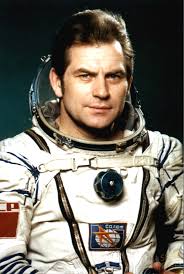Vladimir Kovalyonok
Russian - (RFSA)
Retired
Date of Birth: March 3, 1943
Age: 82
Vladimir Vasiliyevich Kovalyonok (Belarusian: Уладзі́мір Васі́льевіч Кавалёнак; Russian: Влади́мир Васи́льевич Ковалёнок; born March 3, 1942 in Beloye, Minsk Oblast, Belorussian SSR, is a retired Soviet cosmonaut. He entered the Soviet space programme on July 5, 1967 and was commander of three missions. He retired from the cosmonaut team on June 23, 1984.
Soyuz U | Soyuz 25
Russian Federal Space Agency (ROSCOSMOS) | RussiaBaikonur Cosmodrome, Republic of Kazakhstan
Oct. 9, 1977, 2:40 a.m.
Status: Success
Mission:
Soyuz 25 was meant to be the first crewed flight to the new Salyut 6 space station. The mission began on October 9, 1977, 02:40:35 UTC, launching Commander Vladimir Kovalyonok and Flight Engineer Valery Rumin into orbit. However, they failed to dock with the station despite five attempts, and had to abort the mission. The mission concluded with a safe landing back on Earth on October 11, 1977, 03:25:20 UTC.
Low Earth OrbitSoyuz-U | Soyuz 29
Russian Federal Space Agency (ROSCOSMOS) | RussiaBaikonur Cosmodrome, Republic of Kazakhstan
June 15, 1978, 8:16 p.m.
Status: Success
Mission:
Soyuz 29 was the fourth mission to visit the Salyut 6 space station and carried the the EO-2 expedition, which was the second long-duration crew for the station. The mission began on June 15, 1978, 20:16:45 UTC, launching Commander Vladimir Kovalyonok and Flight Engineer Aleksandr Ivanchenkov into orbit. They docked with the station the next day. During their 136-day stay on the station, EO-2 crew conducted various scientific experiments, performed an EVA and were visited by three uncrewed Progress cargo spacecrafts and two visiting crews, Soyuz 30 and Soyuz 31. EO-2 crew swapped the vehicles with the Soyuz 31 crew, and returned to Earth in Soyuz 31 spacecraft. The mission concluded with a safe landing back on Earth on November 2, 1978, 11:05:00 UTC.
Low Earth OrbitSoyuz-U | Soyuz 31
Russian Federal Space Agency (ROSCOSMOS) | RussiaBaikonur Cosmodrome, Republic of Kazakhstan
Aug. 26, 1978, 2:51 p.m.
Status: Success
Mission:
Soyuz 31 was the sixth mission to visit the Salyut 6 space station and carried the the EP-4 crew, which visited the long-duration Soyuz 29 resident crew. The mission began on August 26, 1978, 14:51:30 UTC, launching Commander Valery Bukovsky and Research Cosmonaut/Flight Engineer Sigmund Jähn, the first German cosmonaut, into orbit. They docked with the station the next day. During their stay on the station, crew conducted various scientific experiments. Soyuz 31 crew swapped vehicles with the Soyuz 29 (EO-2 expedition) crew, which allowed for a longer stay in orbit for EO-2. The mission concluded with a safe landing back on Earth on September 3, 1978, 11:40:34 UTC.
Low Earth OrbitSoyuz-U | Soyuz T-4
Russian Federal Space Agency (ROSCOSMOS) | RussiaBaikonur Cosmodrome, Republic of Kazakhstan
March 12, 1981, 7 p.m.
Status: Success
Mission:
Soyuz T-4 was the 14th mission to visit the Salyut 6 space station and carried the EO-6 expedition, which was the final long-duration crew for the station. The mission began on March 12, 1981, 19:00:11 UTC, launching Commander Vladimir Kovalyonok and Flight Engineer Viktor Savinykh into orbit. They docked with the station the next day. During their 74-day stay on the station, EO-6 crew conducted various experiments, and were visited by Soyuz 39 and Soyuz 40 crews. The mission concluded with a safe landing back on Earth on May 26, 1981, 12:37:34 UTC.
Low Earth OrbitThe Roscosmos State Corporation for Space Activities, commonly known as Roscosmos, is the governmental body responsible for the space science program of the Russian Federation and general aerospace research. Soyuz has many launch locations the Russian sites are Baikonur, Plesetsk and Vostochny however Ariane also purchases the vehicle and launches it from French Guiana.
Falcon 9
CSG-3
Space Launch Complex 4E - Vandenberg SFB, CA, USACSG-3 is an Earth observation satellite for the Italian Space Agency, part of a reconnaissance constellation using synthetic aperture radars operatin…
Long March 7A
Shijian 29 A-B
201 - Wenchang Space Launch Site, People's Republic of China2 satellites officially described as for "demonstration of new technologies for spatial targets detection" purposes.
Long March 4B
Tianhui 7
Launch Area 94 (SLS-2 / 603) - Jiuquan Satellite Launch Center, People's Republic of ChinaA satellite officially described as for cartography purposes, details TBD.
Soyuz 2.1b/Fregat-M
AIST-2T 01 & 02
Cosmodrome Site 1S - Vostochny Cosmodrome, Siberia, Russian FederationA pair of Russian optical Earth observation satellites built by the Progress Rocket Space Centre for obtaining stereo images of the Earth's surface, …
Long March 3B/E
Fengyun-4C
Launch Complex 2 (LC-2) - Xichang Satellite Launch Center, People's Republic of ChinaChina's geostationary meteorological satellite program FY-4 (Feng Yun 4) is the second generation of chinese geostationary meteorological satellites.



